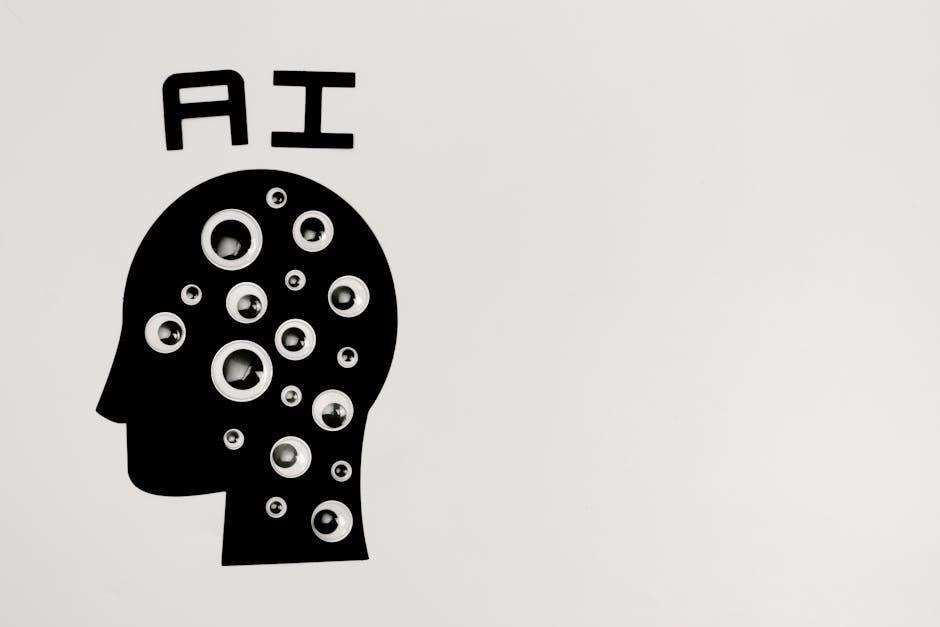Artificial Intelligence (AI) refers to the simulation of human intelligence in machines‚ enabling them to perform tasks like learning‚ reasoning‚ and problem-solving. Emerging in 1956‚ AI aims to create systems that mimic human cognitive abilities‚ revolutionizing technology and society through continuous innovation and advancement.
1.1 What is Artificial Intelligence?
Artificial Intelligence (AI) refers to the simulation of human intelligence in machines‚ enabling them to perform tasks like problem-solving‚ learning‚ and decision-making. It involves creating systems that mimic cognitive functions such as reasoning‚ perception‚ and language understanding. AI is not about replicating human consciousness but rather about developing algorithms and models that allow machines to execute intelligent behaviors. The concept emerged in 1956‚ with John McCarthy coining the term‚ and has since evolved into a diverse field encompassing technologies like Machine Learning and Natural Language Processing. AI systems are designed to analyze data‚ identify patterns‚ and make informed decisions‚ revolutionizing industries and transforming how we interact with technology. Its applications range from autonomous vehicles to healthcare diagnostics‚ showcasing its vast potential.
1.2 A Brief History of AI
The concept of Artificial Intelligence (AI) dates back to ancient myths‚ but the term was formally coined in 1956 by John McCarthy at Dartmouth College. The Dartmouth Summer Research Project on Artificial Intelligence marked the birth of AI as a field of research. Early developments included Alan Turing’s 1950 paper on machine intelligence and the creation of the first AI program in 1956. The 1980s saw the rise of expert systems‚ while the 21st century brought significant advancements in machine learning‚ deep learning‚ and natural language processing. These innovations have transformed AI from a theoretical concept to a practical tool‚ revolutionizing industries and daily life. The evolution of AI reflects humanity’s quest to create machines that think‚ learn‚ and adapt‚ continually pushing technological boundaries.

Key Technologies in Artificial Intelligence
Artificial Intelligence relies on technologies like Machine Learning‚ Deep Learning‚ and Natural Language Processing to enable machines to learn‚ reason‚ and interact with humans effectively.
2.1 Machine Learning and Deep Learning
Machine Learning (ML) is a subset of AI that enables systems to learn from data without explicit programming. Deep Learning (DL)‚ a specialized form of ML‚ uses neural networks with multiple layers to analyze complex patterns. Together‚ they form the backbone of modern AI‚ driving advancements in areas like image recognition‚ speech processing‚ and predictive analytics. These technologies allow machines to improve performance over time‚ making them indispensable in solving real-world problems across industries.
2.2 Natural Language Processing
Natural Language Processing (NLP) is a key technology in AI that enables machines to understand‚ interpret‚ and generate human language. Combining linguistics‚ computer science‚ and machine learning‚ NLP allows systems to process and analyze vast amounts of textual data. Techniques like tokenization‚ sentiment analysis‚ and language modeling are fundamental to NLP. Applications include chatbots‚ language translation‚ speech recognition‚ and text summarization. NLP has revolutionized how humans interact with technology‚ making communication more intuitive and efficient. Its advancements continue to enhance various industries‚ from customer service to healthcare‚ by automating and improving language-based tasks. As AI evolves‚ NLP remains a cornerstone‚ driving innovation in human-computer interaction and beyond.

Applications of Artificial Intelligence
AI transforms industries like healthcare‚ finance‚ transportation‚ and education‚ enhancing diagnostics‚ fraud detection‚ autonomous vehicles‚ predictive maintenance‚ personalized learning‚ and smart traffic systems‚ driving efficiency and innovation.
3.1 Healthcare and Medicine
Artificial Intelligence is revolutionizing healthcare by enhancing disease diagnosis‚ drug discovery‚ and patient care. AI algorithms analyze medical data to identify patterns‚ enabling early detection of conditions like cancer and diabetes. In radiology‚ AI improves image interpretation‚ reducing diagnostic errors. Additionally‚ AI-powered chatbots assist in patient monitoring‚ while predictive analytics optimize treatment plans; AI also accelerates drug development by simulating molecular interactions‚ reducing costs and time. Personalized medicine benefits from AI’s ability to tailor treatments to individual genetic profiles. Furthermore‚ AI supports telemedicine‚ expanding access to healthcare services. Overall‚ AI enhances accuracy‚ efficiency‚ and accessibility in healthcare‚ transforming how medical professionals deliver care and improving patient outcomes significantly.
3.2 Finance and Banking
Artificial Intelligence is transforming the finance and banking sector by enhancing operational efficiency and decision-making. AI algorithms detect fraudulent transactions in real-time‚ reducing financial losses. In trading‚ AI enables algorithmic decision-making‚ optimizing portfolio management and risk assessment. AI also improves customer service through chatbots‚ providing personalized financial advice and streamlining account management. Additionally‚ AI aids in regulatory compliance by automating reporting and monitoring processes. Machine learning models analyze vast datasets to predict market trends‚ helping investors make informed decisions. Overall‚ AI in finance enhances security‚ accuracy‚ and customer satisfaction‚ driving innovation and competitiveness in the banking industry while ensuring compliance with evolving regulatory requirements.

Ethical Considerations in AI
AI raises critical ethical issues‚ including privacy concerns‚ algorithmic bias‚ and transparency. Ensuring fairness and accountability in AI systems is essential to balance innovation with societal responsibility.
4.1 Privacy and Data Security
Artificial Intelligence systems often rely on vast amounts of personal data‚ raising significant privacy concerns. Ensuring data security is critical to prevent misuse and unauthorized access. AI technologies must adhere to strict regulations to protect sensitive information. Data anonymization and encryption are essential to safeguard user privacy. However‚ the complexity of AI systems can introduce vulnerabilities‚ making them targets for cyberattacks. Striking a balance between innovation and privacy is paramount. Ethical AI practices emphasize transparency and accountability to maintain public trust. As AI evolves‚ addressing these challenges becomes increasingly urgent to ensure responsible data handling and secure systems.
4.2 Bias and Fairness in AI Systems
AI systems can perpetuate biases present in training data‚ leading to unfair outcomes. Ensuring fairness requires diverse datasets and algorithms that minimize discrimination. Bias can affect decision-making in areas like hiring‚ healthcare‚ and law enforcement. Addressing these issues involves audits and transparency to identify and mitigate biases. Fairness in AI is crucial for ethical deployment‚ requiring ongoing efforts to develop inclusive technologies that serve all populations without prejudice. Achieving unbiased AI systems remains a significant challenge‚ necessitating collaboration across industries to establish equitable practices and standards.

The Future of Artificial Intelligence
AI’s future holds rapid advancements in generative models‚ autonomous systems‚ and personalized solutions. Emerging technologies will reshape industries‚ offering unprecedented opportunities while raising ethical and societal challenges.
5.1 Emerging Trends in AI
Artificial Intelligence is rapidly evolving‚ with emerging trends like generative models‚ autonomous systems‚ and ethical AI gaining prominence. Generative AI‚ capable of creating content‚ is transforming industries from entertainment to healthcare. Autonomous systems‚ such as self-driving vehicles‚ are advancing with improved safety and efficiency. Additionally‚ there is a growing focus on explainable AI (XAI)‚ ensuring transparency in decision-making processes. Investments in AI infrastructure and collaboration between academia and industry are accelerating innovation. These trends are reshaping sectors like education‚ finance‚ and manufacturing‚ offering unprecedented opportunities. However‚ they also raise ethical and regulatory challenges‚ emphasizing the need for balanced growth and responsible AI development.
5.2 The Impact of AI on Society
Artificial Intelligence is profoundly impacting society by transforming industries and daily life. In healthcare‚ AI enhances diagnostics and personalized treatments‚ improving patient outcomes. Education benefits from tailored learning experiences‚ making knowledge more accessible. Autonomous vehicles and smart traffic systems reduce accidents and improve mobility. AI-driven tools boost productivity in finance‚ manufacturing‚ and agriculture‚ fostering economic growth. However‚ concerns arise about job displacement‚ privacy‚ and ethical use. Balancing innovation with regulation is crucial to ensure AI benefits society equitably. Collaborative efforts between governments‚ industries‚ and experts are essential to address challenges and harness AI’s potential for global betterment.

AI in Education
AI transforms education by personalizing learning‚ automating tasks‚ and providing real-time feedback‚ enabling students to access tailored resources and improving overall educational accessibility and quality.
6.1 Personalized Learning Experiences
Artificial Intelligence (AI) revolutionizes education by offering personalized learning experiences tailored to individual student needs. Adaptive learning platforms use machine learning to analyze student performance‚ adapting content difficulty and pacing. Intelligent tutoring systems provide one-on-one support‚ addressing specific weaknesses and enhancing engagement. Natural Language Processing (NLP) enables interactive tools that simulate human-like conversations‚ making learning more immersive. AI-driven analytics predict student outcomes‚ allowing educators to intervene early and improve success rates. These technologies also support diverse learning styles‚ catering to visual‚ auditory‚ and kinesthetic learners. By fostering a student-centric approach‚ AI helps bridge gaps in traditional education‚ ensuring equitable access to high-quality learning opportunities. This personalized method not only boosts academic performance but also prepares students for a rapidly evolving‚ technology-driven world.
6.2 AI Tools for Educational Research
Artificial Intelligence (AI) significantly enhances educational research by providing advanced tools for data analysis‚ pattern recognition‚ and automation. Natural Language Processing (NLP) enables researchers to analyze vast amounts of textual data‚ identifying trends and insights. Machine Learning algorithms can predict educational outcomes and optimize learning environments. AI-powered tools automate tasks such as literature reviews‚ data collection‚ and statistical analysis‚ saving time and reducing errors. Additionally‚ AI facilitates the creation of adaptive assessments and personalized learning paths. These technologies also support collaborative research by connecting scholars globally and fostering knowledge sharing. By leveraging AI‚ educational research becomes more efficient‚ accurate‚ and innovative‚ ultimately improving educational policies and practices. AI tools democratize access to advanced research capabilities‚ benefiting both institutions and individual researchers. This transformation is reshaping how education is studied and improved worldwide.

AI in Transportation
Artificial Intelligence revolutionizes transportation by enhancing safety‚ efficiency‚ and sustainability. Autonomous vehicles‚ predictive analytics‚ and smart traffic management reduce congestion and emissions‚ improving urban mobility globally.
7.1 Autonomous Vehicles
Autonomous vehicles represent a transformative application of AI in transportation. By leveraging machine learning and sensor data‚ these systems enable cars to navigate without human intervention. AI algorithms process environmental inputs‚ such as traffic patterns and pedestrian movements‚ to make real-time decisions. Autonomous vehicles enhance safety by reducing human error‚ improve traffic flow‚ and provide mobility solutions for the elderly and disabled. Applications extend to public transport and ride-sharing services‚ optimizing routes and reducing fuel consumption. However‚ ethical and regulatory challenges remain‚ including liability in accidents and data privacy concerns. The development of autonomous vehicles relies on collaboration between tech companies‚ automakers‚ and governments to address these issues and ensure widespread adoption. This technology promises to revolutionize logistics and urban planning‚ creating smarter‚ safer transportation networks globally.
7.2 Smart Traffic Management
Smart traffic management leverages AI to optimize urban mobility by analyzing real-time data from sensors‚ cameras‚ and GPS systems. AI algorithms predict traffic flow‚ reduce congestion‚ and minimize travel time through dynamic traffic light control and route optimization. These systems integrate with autonomous vehicles and public transport to enhance coordination and efficiency. AI also aids in incident detection‚ such as accidents or road closures‚ enabling faster response times. By reducing traffic jams and lowering emissions‚ smart traffic management contributes to sustainable urban development. However‚ challenges like data privacy and system integration must be addressed to ensure seamless functionality. The implementation of AI in traffic management is crucial for creating smarter‚ more livable cities‚ improving quality of life for residents and commuters alike while supporting environmental goals.

AI in Manufacturing
AI transforms manufacturing by enhancing productivity‚ reducing waste‚ and optimizing production processes through advanced analytics‚ predictive maintenance‚ and IoT integration‚ ensuring efficient and sustainable operations.
8.1 Predictive Maintenance
Predictive maintenance‚ powered by AI‚ revolutionizes manufacturing by forecasting equipment failures before they occur. Using machine learning algorithms and IoT sensors‚ systems analyze real-time data to detect anomalies and predict downtime. This approach reduces unplanned halts‚ optimizes maintenance schedules‚ and extends equipment lifespan. By identifying potential issues early‚ manufacturers minimize repair costs and enhance operational efficiency. AI-driven predictive maintenance also enables resource allocation and reduces inventory needs for spare parts. This technology is particularly valuable in industries with high capital equipment‚ such as automotive and aerospace‚ where downtime can lead to significant financial losses. Overall‚ predictive maintenance ensures smoother production processes and contributes to the overall sustainability of manufacturing operations.
8.2 Optimizing Supply Chains
Artificial Intelligence significantly enhances supply chain management by optimizing operations through data-driven insights. Machine learning algorithms analyze real-time data to forecast demand‚ reduce overstocking‚ and minimize shortages. AI-powered systems streamline logistics‚ enabling dynamic route optimization to lower fuel consumption and emissions. Additionally‚ AI automates warehouse operations‚ such as inventory tracking and order fulfillment‚ improving efficiency. Predictive analytics also help identify potential bottlenecks‚ allowing proactive adjustments. Furthermore‚ AI facilitates better collaboration between suppliers‚ manufacturers‚ and distributors by providing transparent and shared data platforms. These advancements ensure a more agile and responsive supply chain‚ reducing costs and enhancing customer satisfaction. By leveraging AI‚ businesses can achieve end-to-end supply chain visibility and resilience‚ ultimately driving long-term competitiveness in the global market.

Legal and Regulatory Challenges
AI raises complex legal issues‚ including privacy concerns‚ data security risks‚ and algorithmic bias. Regulatory frameworks struggle to keep pace with rapid technological advancements‚ requiring balanced policies that protect rights while fostering innovation.
9.1 AI and Legal Frameworks
Artificial Intelligence poses significant challenges to existing legal systems‚ raising questions about accountability‚ transparency‚ and liability. Current frameworks often struggle to address AI-specific issues‚ such as algorithmic bias and data privacy. As AI becomes more pervasive‚ there is a growing need for updated regulations to ensure ethical deployment and use. Legal systems must evolve to define clear guidelines for AI development‚ deployment‚ and oversight‚ balancing innovation with societal protection. Additionally‚ international cooperation is crucial to establish uniform standards‚ as AI’s impact transcends national boundaries. The development of comprehensive legal frameworks will be essential to mitigate risks and ensure that AI technologies are used responsibly and for the public good.
9.2 Regulatory Challenges in AI Development

AI development faces significant regulatory challenges‚ primarily due to rapid technological advancements outpacing legal frameworks. Issues like data privacy‚ algorithmic bias‚ and transparency require updated regulations. Existing laws often fail to address AI-specific concerns‚ such as accountability for autonomous decisions. Ensuring compliance with regulations like GDPR while fostering innovation is complex. Additionally‚ the global nature of AI necessitates international cooperation to harmonize standards‚ yet differing priorities across countries complicate this process. Balancing innovation with ethical and legal safeguards remains a critical challenge for policymakers aiming to create frameworks that promote responsible AI development while mitigating risks to society and individuals;
